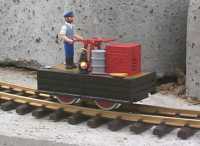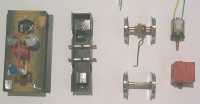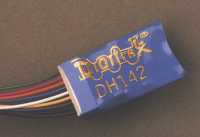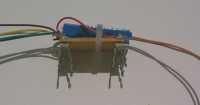

All modifications described herein are done at your own risk !
| Home Garden Railway Digital Conversions |  |
 |
The disassembly of the 20010 is relatively simple. First, I removed the red crate
on the hand trolley (2 screws). The motor can be now pulled out. I then carefully
pulled off the two motor terminals using needle-nose pliers. Next, I loosened the two screws at the bottom and carefully removed the lower shell. I also removed the two axles. A small PCB (printed circuit board) is snapped onto the 4 current collectors. I removed this PCB to mount the decoder on it. |
 |
The decoder I used for the hand trolley is the Digitrax DH142. It can handle 1.5A of current in continuous operation and has back-emf load compensation. The design is compact and the cables are connected directly to the decoder via a special plug. |
 |
I fastened the decoder directly onto the PCB of the current pick-ups using a small cable strap. The two wires for the track connection were soldered directly to the PCB. |
 |
The assembly takes place in the reverse order of the original disassembly. I soldered
the two motor connectors to the appropriate wires of the decoder. During programming of the decoder, I changed some of the CVs which control the back-emf load compensation (CV55 = 0x30, CV56 = 0x20, CV57 = 0x03, all Hex values!!). With these values the handcar starts reliably and runs at medium speed quite steadily. Unfortunately, at the lower speed range it's jerky, but this problem is caused mainly by the lever mechanism |
Translated by Knut Schartmann